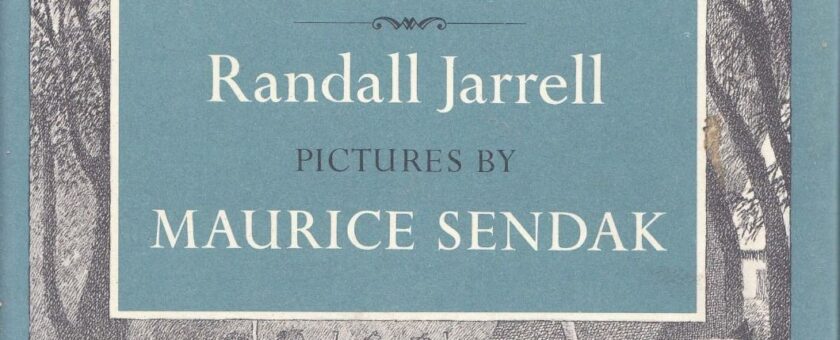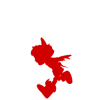
No Talking Tuesday # 125
- posted in: No Talking Tuesdays
- / with 0 comments
February 23, 2010
I made a mistake this week. My morning ritual for a while has been a slice of pie with coffee and orange. The meal ends with a little piano improvisation before I go to work.
I’ve been collecting antique children’s books for a while and read them during breakfast. I like antique children’s books because they’re scary and deal explicitly with death and greed, revenge, malice etc. It was Tuesday when I read Fly by Night by Randall Jarrell, illustrated by Maurice Sendak. My no talking defenses weren’t up yet as I was alone in the dining room reading. But when I finished reading the first two pages, I was so struck by the strength of the writing I accidentally said out loud: “Wow.” I vented my self loathing on a dramatically angry piano improvisation before leaving for work. My idiocy notwithstanding, the writing was fantastic and of course Sendak’s illustrations are on point as they always are. Here was the passage that frazzled me:
- If you turn right at the last stoplight on New Garden Road and go north for a mile and a half, you come to a lake on a farm. Beyond, at the edge of the forest, there is a house with a window seat and a big willow-the house is covered with ivy, and the ivy is full of sparrows’ nests. If you walk along the edge of the yard, outside the hedge, a big red chow walks along by you on the inside, barking and wagging his tail. Sometimes there is a cat on the porch, a striped gray one.
A little boy lives there-sometimes you see him sitting in a tree house in the willow. He sits in it so much that the sparrows are used to him, and light just out of reach in the branches. When he takes the cat up with him, though, they sit in the ivy and scold; the cat never stays long.
The boy plays on the lawn with the dog and cat or in the forest with the dog-there aren’t any children for him to play with. In the middle of the afternoon he goes and stands by the mailbox, so that the mailman can hand the mail to him instead of putting it in the box. But sometimes he stays in his tree house and waves, and the mailman waves back from his car. Sometimes the mailman hears him calling, “Here Reddy! Here Reddy!” to the dog. The cat’s name is Flour, the boy’s name is David.
At night David can fly.
In the daytime he can’t. In the daytime he doesn’t even remember that he can.
The List:
heart smart burrito
with rice please
-regular
black, whole wheat
well this is just an outline of every point i could conceivably touch on
my guess is that this mostly overlaps with the choc mool paper?
should i maybe focus on point three?
so should the whole paper sort of be a case study of that piece
i could do either, but all the points you hit are all in the process used for the frieze, so there wouldn’t be much need to go outside
well i have a serpent head i did from scratch for that example
well if we touch on that stuff at all we should probably do it briefly as you say
though if you want to get into the workflow of working with the archeological examples
the ball court, frieze, etc. could take a while to wrangle that stuff, step through it, talk about all the factors etc.
i don’t really care, i think the uv point is small potatoes to the other stuff
no when you apply a displacement map on uprezed uv’d low rez base, some parts would wig out and have spikes etc.
well you could just say work from big changes to small, and separate them out so you can make choices about specific things like surface texture, separate from stuff like how to sculpt the missing area to fit in with the pattern etc.
not with photos on site, but texture photos
right, the bullet was in reference to painting texture by hand vs. using photo projects and layering etc. but as another point we can talk about using actual photos of the object like i’m sure jun did with the choc mool
well for me the main thing i learned and grew from artistically from this category, was how archeologists don’t think about visual explanations of things, and how exploring that can uncover new points of view, and on a more artistic level, how to build a high rez sclulpt in mudbox with a flexible workflow etc.
well every time we deferred to a archeologist for answers like with the serpent column, and decapitation freeze, they usually hadn’t considered it, but some clues would begin to emerge for me after making subtle connections after looking at tons of reference and working
also things like what color to paint missing parts i was filling in based on what i abstractly observed to be tendencies based on the way other parts of the image and similar images in the reference were colored etc. like how blue was used in small patches, and green for feathers etc. there wasn’t really a existing index of that kind of stuff but it sort of emerged in my head after working on it and holding myself visually accountable for a while which obviously isn’t normal to do as a researcher
well no matter which way you cut it it seems like this paper is going to be a pretty large undertaking, so should we make sure first that we have the time budget for it?
well this one will be hard to get a estimate, i have to re install mudbox and go through old files, and version saves, and there will likely be lots of hiccups along the way like jun just said behind me, it could get done in a week, but i wouldn’t be surprised if it kind of snow balls into something kind of huge, so i just want to make sure if it does that it does the least damage, if that means prioritizing it to be done later, or whatever
well and eventually i think we should do a fry render or something of the frieze since we’ve never seen it presented as realistically as the data was preserved to allow
yea i’m game.
so is there now a drive
no i thought it might be worth doing a comprehensive cross polinization of my philosophy for these papers, but i think it will eat up too much time,
i remember jun was compiling all the maya skies stuff on to one drive? is there now a directory of all the old files i can begin hunting through for all these pieces?
so i can navigate to it through tomonoura?
well they work for the stuff being pointed out in that paper, i can point out the same stuff in the same way, but it would probably be better to just have the images suite the writing, probably be easier to deal with in the long run, also make the images less mish mashy with a clean whitish shader in mudbox and consistent viewpoint etc.
oh and i sussed out the indesign template, spreads thing, and that’s all good now, i have all my pages in one document with master templates for cover and pages.
though i should say since we have elements that will always need to be modified for the content (which is really easy) the automatic functions aren’t especially helpful, but at least having all the pages in one file etc. will stream line things, well kind of
also if it’s not worth everyone coming to speed on that, i can just take everyone’s notepads and images and just do it

Leave a Reply